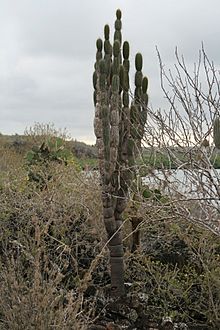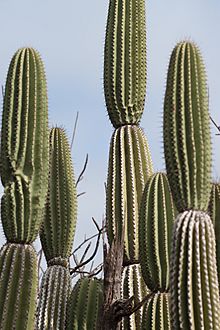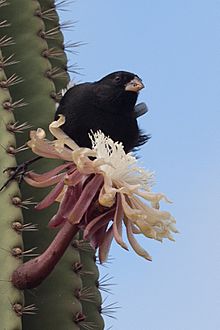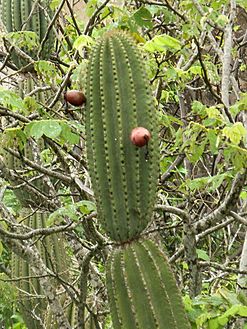Jasminocereus facts for kids
Quick facts for kids Jasminocereus |
|
|---|---|
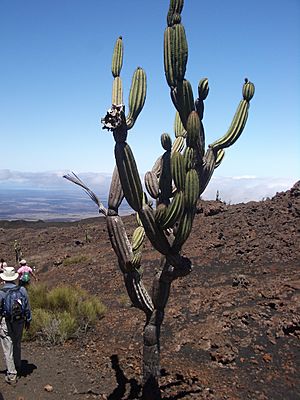 |
|
| Conservation status | |
| Scientific classification | |
| Synonyms | |
|
The Jasminocereus is a special type of cactus that grows only in the Galápagos Islands. These islands are part of Ecuador. This cactus is often called the candelabra cactus because it looks like a branched candle holder. It's the only species in its group, and its scientific name is Jasminocereus thouarsii. When it's fully grown, it can look like a tree and reach up to 7 meters (about 23 feet) tall! Its stems have different sections. The flowers are creamy white or greenish and open at night. After the flowers, it grows greenish or reddish fruits.
Contents
What it Looks Like
The candelabra cactus, Jasminocereus thouarsii, is a treelike cactus that doesn't have leaves. It can grow up to 7 meters (about 23 feet) tall. Its stems are green or yellowish-green and branch out. Each stem is made of sections that are 10 to 50 centimeters (4 to 20 inches) long.
The main trunk and branches have 11 to 22 ribs, which are like raised lines. On these ribs are small bumps called areoles. Each areole can have up to 35 spines. These spines can be as long as 9 centimeters (about 3.5 inches). Their color changes from white to black as they get older.
Flowers and Fruits
The flowers grow one by one and open at night. They are about 6 centimeters (2.4 inches) wide. They have many creamy white, yellow, or olive-green petals and lots of stamens (the parts that make pollen).
After the flowers, the cactus grows a type of berry. These fruits can be greenish to reddish-purple. They contain many small black seeds.
Different Types (Varieties)
Sometimes, people recognize three slightly different types, or varieties, of Jasminocereus thouarsii:
- Jasminocereus thouarsii var. thouarsii: This type has flowers that are not waxy. Its fruits are green. It usually grows under 4 meters (about 13 feet) tall. You can find it on the islands of Floreana, Isabela, San Cristóbal, and Santa Cruz.
- Jasminocereus thouarsii var. delicatus: This type also has flowers that are not waxy. But its fruits are reddish-purple. It grows on Santa Cruz and Santiago islands. Visitors to the Galápagos are most likely to see this variety.
- Jasminocereus thouarsii var. sclerocarpus: This type has waxy flowers and green fruits. It also has the most spines on each areole. It is found only on Fernandina and Isabela islands.
However, many experts, like those who work on the IUCN Red List, do not officially recognize these different varieties. They consider them all to be the same species.
How it Got its Name
The name Jasminocereus means "jasmine-like cereus." This refers to how its flowers look. The name thouarsii comes from Abel Aubert du Petit-Thouars, who found this cactus about 30 years before it was officially named.
Scientists have studied this cactus for a long time. At first, they thought there were two different species, but later they realized they were just different growth stages of the same plant. This is why its scientific name history is a bit complicated!
Family Tree of Cacti
Studies of DNA show that Jasminocereus and another cactus from the Galápagos, Brachycereus, are very closely related. Their closest relative is a cactus from mainland South America called Armatocereus. This helps scientists understand how these cacti evolved.
Where it Lives
The candelabra cactus is found only in the Galápagos Islands. You can see it on Fernandina, Floreana, Isabela, San Cristóbal, Santa Cruz, and Santiago islands, as well as some smaller islets like Bartolomé. It grows in dry areas, from the coast up to about 300 meters (about 984 feet) high on the larger islands.
Protecting the Cactus
In 2002, the Jasminocereus thouarsii was listed as "vulnerable," meaning it was at risk. But by 2013, its status improved to "least concern," which means it's not currently in danger.
It is very important to protect this cactus. The Ecuadorian government strictly controls collecting or disturbing any plants and animals in the Galápagos. The entire area where this cactus grows is part of the Galápagos National Park and a Natural World Heritage Site. This helps keep it safe. Trading this cactus is also controlled by international rules (CITES Appendix II).
Uses
The fruits of the candelabra cactus can be used to make a refreshing fruit juice. This is especially true for the delicatus variety, if you recognize the different types.
See also
 In Spanish: Jasminocereus para niños
In Spanish: Jasminocereus para niños
- Cacti of South America
- Endemic flora of the Galápagos islands



